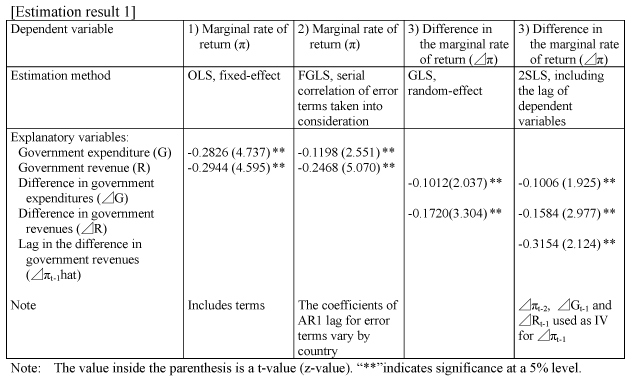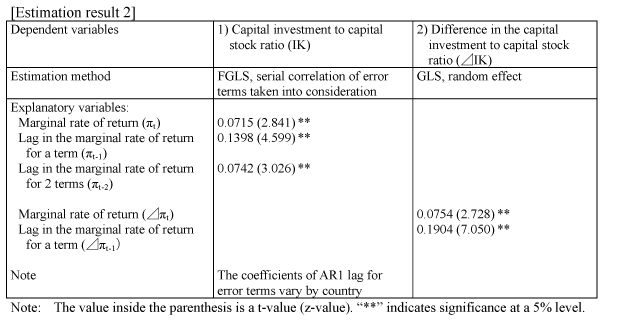Appended Note 1-9 Estimation on the relationship of government spendings and revenues to corporate profits and investments
- Japanese
- English
Following Alesina, Ardagna, Perotti and Schiantarelli (2002) and Alesina, Ardagna, Perotti and Schiantarelli (1999), we estimated the impact that government spendings and revenues have on corporate profits and the impact corporate profits have on capital investments using the panel data between 1980 and 2003. The estimated coefficients were then applied to calculate the scale of impact of government spendings and revenues on corporate capital investments. The variables used in this estimation are as follows. All data are taken from the OECD Economic Outlook Database.
- Marginal rate of return for corporations (
 ): (GDP - Employee's remuneration - Indirect tax + Subsidies)/Capital stock
): (GDP - Employee's remuneration - Indirect tax + Subsidies)/Capital stock - Government spending (G): (Cyclically adjusted general government current expenditure - Interest payment + Net capital expenditure)/Nominal potential GDP
- Government revenue (R): (Cyclically adjusted general government current expenditure and revenue from social insurance premiums)/Nominal potential GDP
- Investment to capital stock ratio (IK): Capital investment by private corporations/Capital stock
- Countries: Australia, Austria, Belgium, Canada, Denmark, Finland, France, Germany, Italia, Ireland, Japan, Netherlands, Norway, Spain, Sweden, United Kingdom, United States
1. Estimation of the relationship between corporate earnings and government spendings/revenues

The "Estimation result 1," which analyzes the relationship between corporate earnings and government spendings/revenues, shows that the government spendings and revenues have negative effects on corporate profits, with, the nearly same size of the coefficients in column 1 when the panel was estimated through a simple fixed-effect method without consideration of the time series correlation. In column 2, where the estimation was conducted taking into account the serial correlation of error terms, the government spendings and revenues still have negative effects on corporate profits, but the coefficients derived here were smaller than in column 1. As for columns 3 and 4, where the primary difference was used for each variable to deal with serial correlation, the coefficients of government spendings and revenues were negative. As such, it could be said that the relationship in which larger government spendings and revenues have negative effects on corporate profits is robust to some extent.
2. Estimation of the relationship between corporate profits and capital investments of private corporations

The "Estimation result 2," which analyzed the relationship between corporate profits and the capital investment to capital stock ratio, shows that the corporate profits had positive effects on investments in both column 1, where estimation was conducted based on the level of variables taking into account the serial correlation of error terms, and column 2, which was based on the primary difference of the variables. With the coefficients derived from the above estimation, the size of impact in terms of the percentage point to push up the capital investment to capital stock ratio when the government spendings and revenues relative to GDP decrease by 1 percentage point is mechanically calculated to be about 0.03 to 0.07 percentage point. (The coefficients from column 2 of the "Estimation result 1" and column 1 of the "Estimation result 2" are used.)
